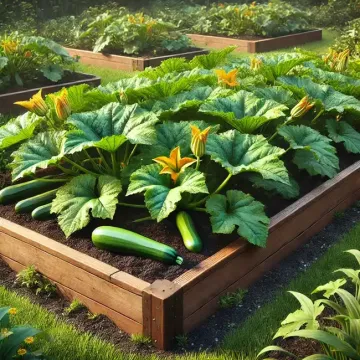Zucchini, a popular summer squash, is a staple in many home gardens due to its ease of growth and prolific harvests. This versatile vegetable can be used in a wide range of dishes, from savory to sweet, making it a must-grow for gardeners who enjoy fresh, homegrown produce. In this article, we’ll explore the history of zucchini, its health benefits, culinary uses, and provide essential growing tips to help you cultivate a successful zucchini crop in your home garden.
History of Zucchini
Zucchini (Cucurbita pepo) is native to Central and South America, where it was cultivated by indigenous peoples thousands of years ago. The zucchini we know today, however, was developed in Italy in the late 19th century. The word "zucchini" is derived from the Italian word "zucchino," meaning small squash. It wasn’t until Italian immigrants brought zucchini seeds to the United States in the early 20th century that the vegetable gained popularity in North America. Today, zucchini is a beloved garden crop around the world.
Health Benefits of Zucchini
Zucchini is a nutrient-dense vegetable, offering numerous health benefits. It is low in calories and high in water content, making it a great choice for those looking to maintain a healthy weight. Zucchini is also a good source of vitamin C, vitamin A, potassium, and antioxidants, which support immune function, eye health, and heart health. The dietary fiber in zucchini promotes healthy digestion, while its high water content helps with hydration.
Culinary Uses of Zucchini
Zucchini's mild flavor and tender texture make it a versatile ingredient in the kitchen. It can be grilled, roasted, sautéed, or steamed, and is a great addition to stir-fries, pasta dishes, soups, and casseroles. Zucchini is also commonly used in baking, such as zucchini bread, muffins, and cakes, where it adds moisture without altering the flavor. For a low-carb alternative to pasta, zucchini can be spiralized into "zoodles" or thinly sliced for use in lasagna.
Growing Zucchini in Your Home Garden
Zucchini is a relatively easy vegetable to grow, even for beginner gardeners. Here are some tips to help you get started:
Planting Time:
Zucchini is a warm-season crop, so it should be planted after the last frost date in your area. The soil temperature should be at least 60°F (15°C) for optimal germination. You can start zucchini seeds indoors 3-4 weeks before transplanting them outside, or sow seeds directly into the garden once the soil has warmed.
Soil Requirements:
Zucchini thrives in well-draining soil that is rich in organic matter. A pH level of 6.0 to 7.5 is ideal. To improve soil fertility, mix compost or well-rotted manure into the planting area before sowing seeds or transplanting seedlings.
Spacing and Sunlight:
Zucchini plants can grow quite large and need plenty of space to spread out. Plant seeds or seedlings about 2 to 3 feet apart in rows that are spaced 4 to 6 feet apart. Zucchini needs full sun, so choose a location in your garden that receives at least 6 to 8 hours of direct sunlight each day.
Watering:
Zucchini plants have a high water requirement, especially during hot summer months. Water the plants deeply at the base, making sure to keep the soil consistently moist but not waterlogged. Mulching around the plants can help retain moisture and reduce the risk of weeds.
Fertilization:
Zucchini is a heavy feeder, so it benefits from regular fertilization throughout the growing season. Use a balanced fertilizer, such as a 10-10-10 NPK formula, and apply it according to the package instructions. You can also supplement with compost or organic liquid fertilizers to boost growth.
Pollination:
Zucchini plants produce both male and female flowers, and successful pollination is essential for fruit development. Bees and other pollinators are usually responsible for this process, but if pollination is lacking, you can hand-pollinate by transferring pollen from male flowers to female flowers using a small paintbrush or cotton swab.
Harvesting:
Zucchini grows quickly and should be harvested regularly to encourage continuous production. The ideal size for harvesting is when the zucchini is about 6 to 8 inches long and still tender. If left on the plant too long, zucchini can become oversized and tough. Use a sharp knife or garden shears to cut the zucchini from the vine, leaving a small portion of the stem attached.
Pest and Disease Management:
Common pests that affect zucchini plants include squash bugs, cucumber beetles, and aphids. Regularly inspect your plants for signs of infestation and use organic insecticides or insecticidal soap if necessary. Powdery mildew is a common fungal disease in zucchini, especially in humid conditions. To prevent this, water at the base of the plants and avoid overhead watering. Removing affected leaves and applying fungicides can help manage the spread of the disease.
Companion Planting:
Zucchini grows well alongside companion plants such as beans, corn, and radishes. These plants can help repel pests and improve soil fertility. Avoid planting zucchini near potatoes, as they compete for nutrients and attract similar pests.
Growing zucchini in your home garden is a rewarding experience that provides you with an abundance of fresh, delicious produce. With its rapid growth, high yields, and versatility in the kitchen, zucchini is a must-have crop for gardeners of all skill levels. By following these simple growing tips, you’ll be well on your way to enjoying a bountiful harvest of zucchini all season long.

